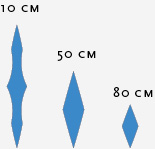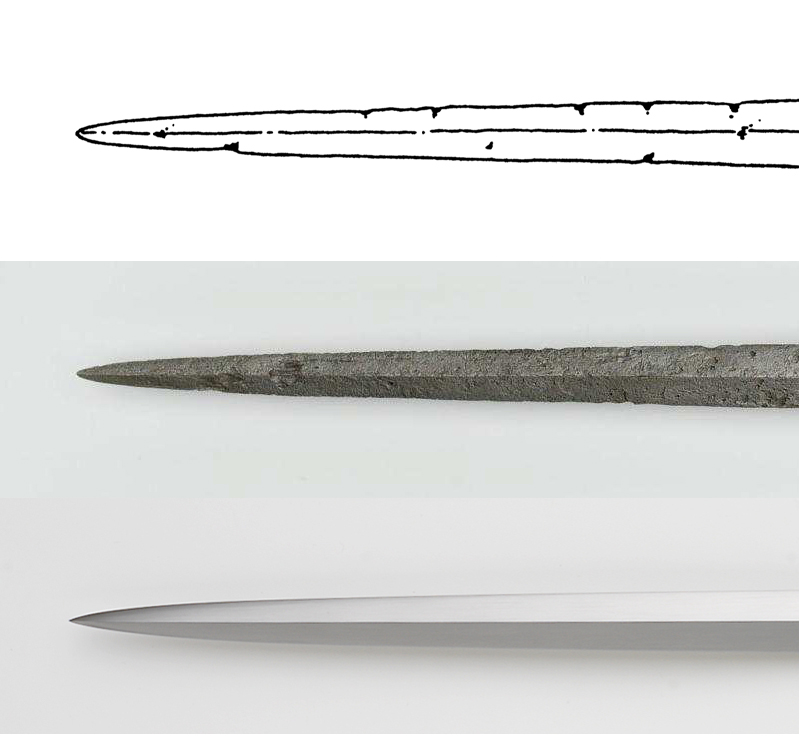In one of my recent discussions with Carlos Cordeiro we were comparing the performance of type XVa and XVIIIb longswords (a quick tip: the former type is Black Prince's, the later the Munich's), but I was surprised with his claim that your typical type XVa longsword thrusts better than any XVIIIb could ever hope for, while XVIIIb were notably better cutters than any type XVa.
His argument is that cut performance is takes the center of percussion as reference: while XVa starts wider at the crossguard, by the CoP she's always slimmer than the XVIIIb, which doesnt tapper to much whatsoever, either distal or profile-wise. And since it doesn't taper much, the point is more acute in XVa than in XVIIIb, so the XVa is the better thruster;
An example he made: "one XVa can have 8mm of thickness and 50mm of width at base, and have 6mm of thickness and 15mm of width near the point. The XVIIIb can have the same 8mm of thickness and 50mm of width near the base, but it's going to have the double of width and half of the thickness near the point. It's an issue of mass distribution. Type XVIIIb are duck swords, can be decent at cutting and thrusting, but never as good as specific cutting and thrusting longswords;
What's your thoughts?
Since the criteria for assigning a sword to a specific Oakeshott type isn't really that exact, this isn't so simple. For instance Peter Johnsson and Albion classify National Museum of Slovenia sword N4516, and it's replica Albion Ljubljana as Oakeshott Type XVIIIb. I guess the main criteria for assigning it to this type is a slight widening of the blade near the tip, and the curve towards the tip. I think this is a bit more prominent on the replica, Albion Ljubljana as it is on the original, but this might be Peter Johnsson's reconstruction of original shape of the blade due to the angles in cross section and evidence of reshaping in it's working life, probably due to damage.
But National Museum of Slovenia sword N4516 and it's replica Albion Ljubljana are much more typical thrust oriented sword than typical Type XVIIIb - it has a very strong profile taper, while the blade thickness remains very high, so the cross section at the Centre of Percussion, although it is quite back, isn't very cut optimized.
 Attachment: 9.11 KB
Attachment: 9.11 KB

 Attachment: 161.03 KB
Attachment: 161.03 KB

 Attachment: 558.98 KB
Attachment: 558.98 KB
[ Download ]
 Attachment: 192.33 KB
Attachment: 192.33 KB
[ Download ]
But National Museum of Slovenia sword N4516 and it's replica Albion Ljubljana are much more typical thrust oriented sword than typical Type XVIIIb - it has a very strong profile taper, while the blade thickness remains very high, so the cross section at the Centre of Percussion, although it is quite back, isn't very cut optimized.


[ Download ]
[ Download ]
| Blaz Berlec wrote: |
| Since the criteria for assigning a sword to a specific Oakeshott type isn't really that exact, this isn't so simple. For instance Peter Johnsson and Albion classify National Museum of Slovenia sword N4516, and it's replica Albion Ljubljana as Oakeshott Type XVIIIb. I guess the main criteria for assigning it to this type is a slight widening of the blade near the tip, and the curve towards the tip. I think this is a bit more prominent on the replica, Albion Ljubljana as it is on the original, but this might be Peter Johnsson's reconstruction of original shape of the blade due to the angles in cross section and evidence of reshaping in it's working life, probably due to damage.
But National Museum of Slovenia sword N4516 and it's replica Albion Ljubljana are much more typical thrust oriented sword than typical Type XVIIIb - it has a very strong profile taper, while the blade thickness remains very high, so the cross section at the Centre of Percussion, although it is quite back, isn't very cut optimized. |
I dont remember seeing a type XVIIIb with a fuller, this reminds me more of a Brescia Spadona. I'm not an expert on classifying these typologies (and Peter once said he changed opinions on some stuff he classified in the past, great guy btw), but I would suggest either a type XVIa or a hybrid.
By the way, the original you send has a fillet/ridge/spine in the center much like the ones seen in estocs/panzerstechers. I think this was lost in the Albion interpretation somewhat.
Some of these were made in longsword and one handed sword blades, probably to remove weight and not going full diamond shaped.
https://www.metmuseum.org/art/collection/search/25627
Well, the National Museum of Slovenia sword N4516 doesn't fit any of the Oakeshott typologies neatly, and that's why it could be placed in many of them - with notes on how it differs from the type standard.
It might look on some photos like Albion Ljubljana is different than Slovenia sword N4516, but it's mainly just due to different lighting, corrosion and patina on the original that sometimes masks the shape or makes it look different than it is. The " fillet/ridge/spine in the center much like the ones seen in estocs/panzerstechers" is the ridge on the wider part of the blade between the two shallow fullers. The general cross section shape is that of a diamond throughout.
 Attachment: 263.81 KB
Attachment: 263.81 KB
[ Download ]
It might look on some photos like Albion Ljubljana is different than Slovenia sword N4516, but it's mainly just due to different lighting, corrosion and patina on the original that sometimes masks the shape or makes it look different than it is. The " fillet/ridge/spine in the center much like the ones seen in estocs/panzerstechers" is the ridge on the wider part of the blade between the two shallow fullers. The general cross section shape is that of a diamond throughout.
[ Download ]
Sorry for the thread necro, but I can't help but bring this up-- Cluny XVIIIb, anyone?
That example is practically a rapier with a longsword hilt, with a center of percussion rather close to the cross (given its' overall blade length), and the final third of the blade closest to the tip is slimmer than many (I'd even say "most") XVa's...
That example is practically a rapier with a longsword hilt, with a center of percussion rather close to the cross (given its' overall blade length), and the final third of the blade closest to the tip is slimmer than many (I'd even say "most") XVa's...
Page 1 of 1
You cannot post new topics in this forumYou cannot reply to topics in this forum
You cannot edit your posts in this forum
You cannot delete your posts in this forum
You cannot vote in polls in this forum
You cannot attach files in this forum
You can download files in this forum
All contents © Copyright 2003-2006 myArmoury.com — All rights reserved
Discussion forums powered by phpBB © The phpBB Group
Switch to the Full-featured Version of the forum
Discussion forums powered by phpBB © The phpBB Group
Switch to the Full-featured Version of the forum